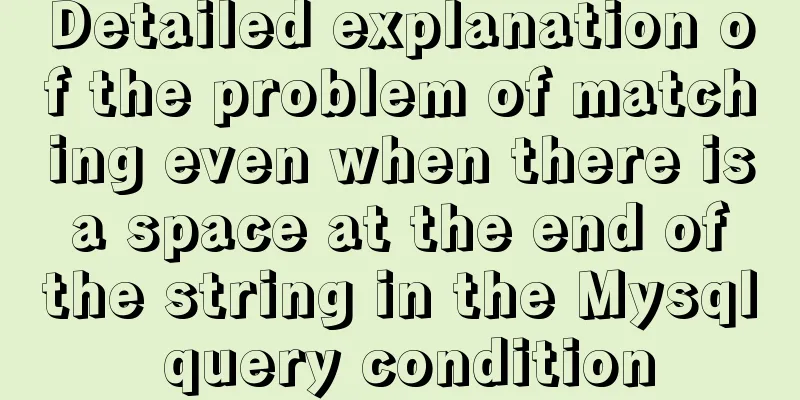Summary of SQL query optimization knowledge points for MySQL tens of millions of big data

|
1. To optimize the query, try to avoid full table scans. First, consider creating indexes on the columns involved in where and order by. 2. Avoid using null value judgment on fields in the where clause, otherwise the engine will abandon the use of indexes and perform a full table scan, such as: select id from t where num is null. You can set a default value of 0 on num to ensure that there is no null value in the num column in the table, and then query like this: select id from t where num=0 3. Try to avoid using the != or <> operator in the where clause, otherwise the engine will give up using the index and perform a full table scan. 4. Avoid using or to connect conditions in the where clause, otherwise the engine will abandon the use of the index and perform a full table scan. For example, select id from t where num=10 or num=20 can be queried like this: select id from t where num=10 union all select id from t where num=20 5. Use in and not in with caution, otherwise it will cause a full table scan, such as: select id from t where num in(1,2,3) For consecutive values, use between instead of in: select id from t where num between 1 and 3 6. The following query will also result in a full table scan: select id from t where name like '%李%' To improve efficiency, you can consider full-text retrieval. 7. If you use parameters in the where clause, it will also cause a full table scan. Because SQL resolves local variables only at run time, the optimizer cannot defer the choice of an access plan until run time; it must make the choice at compile time. However, if the access plan is built at compile time, the value of the variable is still unknown and cannot be used as an input for index selection. The following statement will perform a full table scan: select id from t where num=@num You can change it to force the query to use the index: select id from t with(index(index name)) where num=@num 8. Try to avoid expression operations on fields in the where clause, as this will cause the engine to abandon the use of indexes and perform a full table scan. For example: select id from t where num/2=100 should be changed to: select id from t where num=100*2. 9. Try to avoid performing function operations on fields in the where clause, as this will cause the engine to abandon the use of indexes and perform a full table scan. For example: select id from t where substring(name,1,3)='abc', the id whose name starts with abc should be changed to: select id from t where name like 'abc%'. 10. Do not perform functions, arithmetic operations, or other expression operations on the left side of "=" in the where clause, otherwise the system may not be able to use the index correctly. 11. When using an index field as a condition, if the index is a composite index, the first field in the index must be used as a condition to ensure that the system uses the index. Otherwise, the index will not be used, and the field order should be consistent with the index order as much as possible. 12. Do not write meaningless queries, such as if you need to generate an empty table structure: select col1,col2 into #t from t where 1=0. This type of code will not return any result set, but will consume system resources. It should be changed to: create table #t(…). 13. In many cases, it is a good choice to use exists instead of in: select num from a where num in(select num from b), replace it with the following statement: select num from a where exists(select 1 from b where num=a.num). 14. Not all indexes are effective for queries. SQL optimizes queries based on the data in the table. When there is a large amount of repeated data in the index column, the SQL query may not use the index. For example, if a table has a sex field with almost half male and half female, then even if an index is built on sex, it will not affect the query efficiency. 15. The more indexes, the better. Although indexes can improve the efficiency of corresponding selects, they also reduce the efficiency of inserts and updates, because the index may be rebuilt during inserts or updates. Therefore, how to build indexes requires careful consideration, depending on the specific situation. The number of indexes for a table should not exceed 6. If there are too many, you should consider whether indexes on columns that are not frequently used are necessary. 16. Avoid updating clustered index data columns as much as possible, because the order of clustered index data columns is the physical storage order of table records. Once the column value changes, the order of the entire table records will be adjusted, which will consume considerable resources. If the application system needs to frequently update clustered index data columns, you need to consider whether the index should be built as a clustered index. 17. Try to use numeric fields. If the field only contains numerical information, try not to design it as character type, as this will reduce the performance of queries and connections and increase storage overhead. This is because the engine compares each character in the string one by one when processing queries and connections, but for numeric types, only one comparison is enough. 18. Use varchar/nvarchar instead of char/nchar whenever possible. First, variable-length fields take up less storage space, which can save storage space. Second, for queries, searching in a relatively small field is obviously more efficient. 19. Do not use select * from t anywhere. Replace "*" with a specific list of fields and do not return any unused fields. 20. Try to use table variables instead of temporary tables. If the table variable contains a lot of data, be aware that the indexes are very limited (only the primary key index). 21. Avoid frequent creation and deletion of temporary tables to reduce the consumption of system table resources. 22. Temporary tables are not unusable. Using them appropriately can make certain routines more efficient, for example, when you need to repeatedly reference a certain data set in a large table or a commonly used table. However, for one-time events, it is better to use an export table. 23. When creating a new temporary table, if the amount of data to be inserted at one time is large, you can use select into instead of create table to avoid creating a large amount of logs and increase the speed; if the amount of data is not large, in order to ease the resources of the system table, you should create table first and then insert. 24. If temporary tables are used, be sure to explicitly delete all temporary tables at the end of the stored procedure, first truncate table, then drop table, this can avoid locking the system table for a long time. 25. Try to avoid using cursors because they are less efficient. If the cursor operates on more than 10,000 rows of data, you should consider rewriting it. 26. Before using cursor-based methods or temporary table methods, you should first look for set-based solutions to solve the problem. Set-based methods are usually more effective. 27. Like temporary tables, cursors are not unusable. Using a FAST_FORWARD cursor with small data sets is often superior to other row-by-row processing methods, especially when several tables must be referenced to obtain the required data. Routines that include "aggregates" in the result set will generally execute faster than using cursors. If development time permits, try both the cursor-based approach and the set-based approach to see which one works better. 28. Set SET NOCOUNT ON at the beginning of all stored procedures and triggers and SET NOCOUNT OFF at the end. There is no need to send a DONE_IN_PROC message to the client after each statement in stored procedures and triggers is executed. 29. Try to avoid large transaction operations and improve the system's concurrency capabilities. 30. Try to avoid returning large amounts of data to the client. If the amount of data is too large, consider whether the corresponding demand is reasonable. The above are 30 query optimization techniques we have summarized. Thank you for your learning and support for 123WORDPRESS.COM. If you have any additions, please contact the editor below on QQ. You may also be interested in:
|
<<: Idea packaged into war package deployed to tomcat and access path issues (illustration and text)
>>: Practical skills that must be mastered in calling UNI-APP components in the easycom mode
Recommend
Solve the problem that VMware15 centos7 bridge mode ssh suddenly cannot be accessed
Because I want the virtual machine to have its ow...
Detailed explanation of writing multiple conditions of CSS: not
The :not pseudo-class selector can filter element...
Detailed explanation of the implementation of MySQL auto-increment primary key
Table of contents 1. Where is the self-incremente...
mysql trigger creation and usage examples
Table of contents What is a trigger Create a trig...
Several methods of implementing two fixed columns and one adaptive column in CSS
This article introduces several methods of implem...
Solution to using html2canvas to process Dom elements with Baidu map into images
Problem 1: Baidu Map uses tiled images (the map i...
A complete list of commonly used Linux commands (recommended collection)
Table of contents 1. System Information 2. Shutdo...
The problem of Chinese garbled characters appearing when connecting to MySQL database in Idea
Problem: When using JDBC to connect to the MySQL ...
How to configure /var/log/messages in Ubuntu system log
1. Problem Description Today I need to check the ...
Linux uses bond to implement dual network cards to bind a single IP sample code
In order to provide high availability of the netw...
Analysis of two implementation methods for adding static routing in Linux
Command to add a route: 1.Route add route add -ne...
Login interface implemented by html+css3
Achieve results First use HTML to build a basic f...
CSS overflow-wrap new property value anywhere usage
1. First, understand the overflow-wrap attribute ...
Zen HTML Elements Friends who use zen coding can collect it
html ¶ <html></html> html:xml ¶ <h...
Javascript to achieve drumming effect
This article shares the specific code of Javascri...









